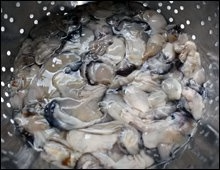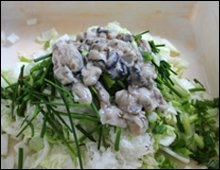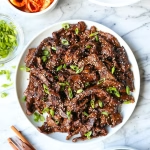
Have you ever tried Gul Kimchi (Oyster Kimchi)? This unique dish adds a delightful twist to the traditional world of kimchi. Originating from Korea, Gul Kimchi is not only famous for its tangy, umami flavors but also for its distinctive and luxurious ingredient—fresh oysters! The combination of fresh seafood and fermented vegetables creates a taste that’s both refreshing and satisfying.
In this article, we’ll dive into the origins and flavors of Gul Kimchi (Oyster Kimchi) and explore how you can bring this fantastic dish into your home kitchen. You’ll find detailed ingredients, easy-to-follow instructions, expert tips, and even some nutritional info. Whether you’re curious about how to make Gul Kimchi (Oyster Kimchi) at home or looking for the best Gul Kimchi (Oyster Kimchi) recipe, we’ve got you covered!
Ingredients
| Ingredient | Measurement | Description |
|---|---|---|
| Fresh Oysters | 1 cup | Fresh oysters provide a briny flavor that pairs beautifully with the spicy, tangy elements of Gul Kimchi (Oyster Kimchi). |
| Napa Cabbage | 1 small | This crunchy vegetable adds texture and absorbs the flavors of the kimchi sauce perfectly. |
| Sea Salt | ½ cup | Sea salt is essential for drawing out moisture and creating that signature kimchi flavor. |
| Garlic | 5 cloves | Fresh garlic enhances the aroma and depth of flavor in Gul Kimchi (Oyster Kimchi). |
| Ginger | 1 tablespoon | Fresh ginger adds a zesty kick, complementing the seafood beautifully. |
| Korean Red Pepper Flakes | 2 tablespoons | This is the key to achieving the authentic spicy kick that Gul Kimchi (Oyster Kimchi) is known for. |
| Fish Sauce | 2 tablespoons | Rich in umami, fish sauce brings depth and complexity to your kimchi. |
| Sugar | 1 teaspoon | A bit of sugar balances the heat and acidity, creating a harmonious flavor profile. |
| Spring Onions | 2, chopped | These add freshness and a mild onion flavor that elevate the dish. |
Step-by-Step Instructions
- Step 1: Prepare the Ingredients – Start by rinsing your fresh oysters under cold water. Next, chop the Napa cabbage into bite-sized pieces and sprinkle sea salt over them. Let this mixture sit for about 30 minutes to draw out excess moisture.
- Step 2: Make the Kimchi Paste – In a blender, combine garlic, ginger, Korean red pepper flakes, fish sauce, and sugar. Blend until you have a smooth paste. This Gul Kimchi (Oyster Kimchi) sauce is key to achieving that delightful flavor!
- Step 3: Combine Ingredients – Once the Napa cabbage is wilted, rinse it under cold water to remove excess salt. In a large mixing bowl, combine the cabbage, chopped spring onions, and the kimchi paste. Mix until all the veggies are well coated.
- Step 4: Add Oysters – Gently fold in the fresh oysters, ensuring they are evenly distributed in the mixture. Be careful not to break them apart too much!
- Step 5: Ferment – Transfer the mix into a clean jar, pressing down to remove air bubbles. Leave some space at the top for fermentation. Seal the jar and let it sit at room temperature for 1-2 days, depending on your preferred level of fermentation. Check daily!
- Step 6: Store & Serve – Once fermented to your liking, store your Gul Kimchi (Oyster Kimchi) in the refrigerator. Serve chilled as a side dish or a topping for rice, tacos, or salads.
Pro Tips
- Be sure to use the freshest oysters available for the best flavor—this is what makes Gul Kimchi truly special.
- Adjust the amount of Korean red pepper flakes based on your spice tolerance. More for a fiery kick, less for a milder taste!
- If you prefer a vegetarian option, try substituting the oysters with oyster mushrooms for a similar texture and taste.
- Fermentation time can vary. Taste your kimchi every day until it reaches your desired sourness.
- Pair Gul Kimchi with grilled meats or rice dishes for a balance of flavors and textures.
Nutritional Information
| Nutrient | Per Serving |
|---|---|
| Calories | 80 |
| Protein | 6g |
| Carbohydrates | 8g |
| Saturated Fats | 1g |
| Fiber | 2g |
| Cholesterol | 20mg |
| Sugars | 1g |
| Fat | 4g |
FAQs
What is the best way to store Gul Kimchi (Oyster Kimchi)?
Store Gul Kimchi in an airtight container in the refrigerator. It can last for up to 2-3 weeks, with flavors becoming more pronounced over time.
Can Gul Kimchi (Oyster Kimchi) be made vegan or gluten-free?
Yes! Substitute oysters with mushrooms for a vegan version, and ensure your fish sauce is gluten-free if needed.
What are the best side dishes to serve with Gul Kimchi (Oyster Kimchi)?
It pairs wonderfully with grilled meats, rice dishes, or even as a topping for tacos and salads.
How long does it take to prepare Gul Kimchi (Oyster Kimchi)?
Preparation time is around 20-30 minutes, with an additional fermentation time of 1-2 days, depending on your taste preference.
Can I freeze Gul Kimchi (Oyster Kimchi) for later?
Freezing is not recommended as it can change the texture of the oysters and vegetables, making them mushy upon thawing.
How spicy is Gul Kimchi (Oyster Kimchi)?
The spice level can be adjusted based on your preference. Add more or less Korean red pepper flakes to suit your taste.
What can I do with leftover Gul Kimchi (Oyster Kimchi)?
Use any leftovers in fried rice, stews, or as a flavorful topping for sandwiches!
Is Gul Kimchi (Oyster Kimchi) healthy?
Absolutely! This dish is low in calories, high in probiotics, and packed with nutrients from fresh vegetables and seafood.
Gul Kimchi (Oyster Kimchi) is not just a dish; it is an experience that brings the essence of Korean culinary traditions right into your kitchen. With its unique flavors and health benefits, it’s a delightful addition to any meal. Whether you’re a seasoned chef or just beginning your cooking journey, making this refreshing dish is easy and rewarding. So why not give it a try?
Tried this Gul Kimchi (Oyster Kimchi) recipe? Let us know your experience in the comments! Happy cooking!





